COMMUNICATION SKILLS ARE VITAL TO ACHIEVING GOOD results when dealing with patients after an injury. One of the most important components of post-injury rehabilitation is to give very clear instructions when the patients first start to exercise. This is because it is easy for patients to do too little or too much, and both will interfere with the desired outcome. It also helps to deal with the common "fear avoidance" of physical use that can develop after an injury. , I find it helpful to communicate two topics specifically: I describe what the patients can expect to feel, and then also how they will know if they have pushed the exercise too far. This is important for those patients who have never exercised before, as well as for the athletes and weekend warriors, who tend to move along too quickly. What to Expect Patients starting to rehab do much better when they know exactly what they can expect to feel as they start doing the exercises. They appreciate the guidance and reassurance, and are more likely to follow through with my rehab recommendations. I begin with the following discussion: "As you start to exercise this area, you are likely to feel some soreness, some stiffness, perhaps even some mild irritation in the involved joints and muscles. That's to be expected, and it means you're working in the right area." This provides the needed encouragement to start exercising after an injury. It also prepares the patients for the expected soreness, so they don't avoid using the injured area out of fear of re-injury. I then tell them it's important to differentiate soreness and stiffness from true pain, which is an indicator that they have gone beyond their current capability. Going Too Far I don't want my patients to continually aggravate the area that is healing so, when they start to do exercises after an injury, I want them to do it so it doesn't cause pain. Some people (athletes in particular) have the idea that exercise has to be painful to be beneficial (the "no pain, no gain" concept). I tell my patients very directly that I don't want them exercising through or beyond a painful point. My cardinal rule is "no pain for maximum gain", and I instruct them to do their exercises in the pain-free range of motion. Unfortunately, I have found that, if I say "pain-free range," most patients will nod their heads in understanding, but not really know what to do. The words sound familiar, but they are not really sure how to implement this in their exercising. To ensure accurate communication, I use a visual concept based on the colors of traffic lights. Red Zone/Green Zone I tell my patients, "As you do this exercise, some stiffness and soreness is to be expected. However, if your body gives you a pain message during the exercise, I want you to pay at- tention. That pain message is your body's warning signal, similar to a caution sign or a yellow traffic light. It doesn't mean you have hurt yourself, but it means that, if you push the exercise beyond this point into the red zone, you risk aggravating your condition and slowing your progress. I want you to do the exercise all the way through the green zone and up to the yellow light. I do not want you to exercise into the red zone. This is not necessary, and is likely to slow your progress." Conclusion Clear, specific guidelines are needed by all patients starting an exercise program; this is especially true for those who are trying to return to normal function after an injury. Rehab programs should be started early in the treatment of patients with injuries, and should take place simultaneously with the biological healing of the injured tissues. Optimal outcomes require patients to understand when to push ahead with their exercises, and when to reduce the exercise stress on the healing tissues. By clearly describing what they can expect to feel, and then providing a visually-cued description of the green zone and red zone, I find that patients are able to perform their exercises with confidence. Dr. Hyland DC, M.P.H.. D.A.C.B.R.. D.A.B.C.O.. C.S.C.S., C.H.E.S. is board-certified in two chiropractic specialties, and is also certified as a Strength and Conditioning Specialist anil a Health Education Specialist. He has 20 years of clinical practice; for eight years he specialized in chiropractic rehabilitation. He is currently a Research Associate at Parker College of Chiropractic, and an Adjunct Professor of Clinical Sciences at the University of Bridgeport's College of Chiropractic. You can contact him at dr/khvlaiuKamsn.coni. References 1. Svvinkcls-Mcewisse IE, Roclofs J. Verbeek AL. el al. Fear of movement/ (re)injury. disability and participation in acute low back pain. Pain 2003; 105(l-2):371-9. 2. Klaber Moftctt JA. CaiT J. Howarth E. High fear-avoidcrs of physical activity benefit from an exercise program for patients with back pain. Spine 2004; 29(11):II67-72. To ensure accurate communication, you can use a visual concept based on the colors of traffic lights: Red: Risk of agravating the condition and slowing progress Yellow: Pain message during workout. Do not push the exercise beyond this point Green: stiffness & soreness experience is to be expected
 View Full Issue
View Full Issue






